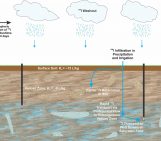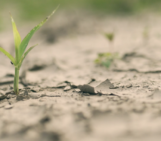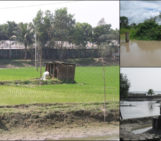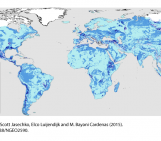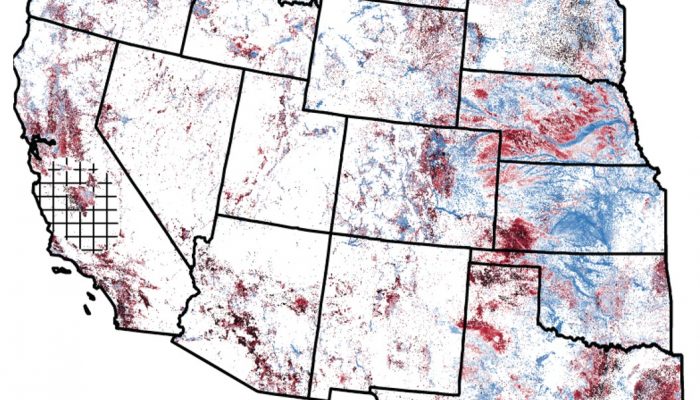
Post by Scott Jasechko, Assistant Professor of Water Resources at the University of Calgary, in Canada, and by Debra Perrone, Postdoctoral Research Scholar at Stanford University, in the United States of America.
__________________________________________________
Wells are excavated structures, dug, drilled or driven into the ground to access groundwater for drinking, cleaning, irrigating, and cooling. We recently mapped groundwater wells across the 17 western states [1], where half of US groundwater pumping takes place. The western states contain aquifers key to United States food production, including the Central Valley of California and the central High Plains.
Millions of water wells exist in the western US, alone. About three-quarters of these wells have been constructed to supply water for household uses. Nearly one-quarter are used to irrigate crops or support livestock. A smaller fraction (<5 %) supports industry [1].
Western US water well depths vary widely (Fig. 1). The great majority (90%) of western US well depths range between 12m and 186m. The median western US well depth is 55m. Wells with depths exceeding 200m tap deep aquifers bearing fresh groundwater, such as the basal formations in the Denver Basin aquifer system, and the deeper alluvium in the California Central Valley. Shallow wells are common along perennial rivers, such as the Yellowstone, Platte, and Willamette Rivers.

Fig. 1. Western USA wells depths. Each point represents the location of a domestic, industrial or agricultural well. Blue colors indicate well depths of less than the median (55m), and red-black colors indicate well depths exceeding the median.
The wide variability of well depths across the west (Fig. 1) emphasizes the value of incorporating well depth data when assessing the likelihood that a groundwater well may go dry.
We know wells are going dry in the western US: journalists have identified numerous communities whose well-water supplies have been impacted by declining water tables [2-4]. While several studies have assessed adverse impacts of groundwater storage declines—such as streamflow depletion [5], coastal aquifer salinization [6], eustatic sea level rise [7], land subsidence [8]—few studies address the question: where have wells have gone dry?
Here we put forth a first estimate of the number of western US wells that have dried up (Fig. 2). We compared well depths to nearby well water level measurements made in recent years (2013-2015). We define wells that have likely gone dry as those with depths shallower than nearby measured well water levels (i.e., our estimate of the depth to groundwater).

Fig. 2. Schematic of a well that has gone dry (left) and a well with a bottom beneath the water table (blue) that may still produce groundwater (right). Even wells with submerged bottoms may be impacted by declines in groundwater storage because (i) pumps are situated above the well bottom, (ii) pumping induces a localized drawdown of the water table in unconfined portions of aquifer systems, (iii) well yields may decline if the hydrostatic pressure above the well base declines.
We estimate that between 0.5% and 6 % of western US wells have gone dry [1]. Dry wells are common in some areas where groundwater storage has declined, such as the California Central Valley [9] and parts of the central and southern High Plains aquifer [10,11]. We also identify lesser-studied regions where dry wells are abundant, such as regions surrounding the towns of Moriarty and Portales in central and eastern New Mexico.
Dry wells threaten the convenience of western US drinking water supplies and irrigated agriculture. Our findings emphasize that dry wells constitute yet another adverse impact of groundwater storage losses, in addition to streamflow depletion [5], seawater intrusion [6], sea level rise [7], and land subsidence [8].
Some wells are more resilient to drying (i.e., deeper) and others more vulnerable (i.e., shallower). We show that typical agricultural wells are deeper than typical domestic water wells in California’s Central Valley and Kansas’ west-central High Plains [1]. Our finding implies that reductions to groundwater storage will disproportionately dry domestic water wells compared to agricultural water wells, because domestic wells tend to be shallower in these areas. However, in other areas, such as the Denver Basin, typical domestic wells are deeper than typical agricultural wells. This comparison of different groundwater users’ well depths may help to identify water wells most vulnerable to groundwater depletion, should it occur.
So, what option does one have when a well goes dry?
Groundwater users whose wells have gone dry may consider a number of potential, short-term remedies, some of which may include (i) drilling a new well or deepening an existing well, (ii) connecting to alternative water sources (e.g., water conveyed by centralized infrastructure; water flowing in nearby streams), or (iii) receiving water delivered by truck.
Drilling new wells, deepening existing wells or connecting to alternate water supplies is often costly or unavailable, raising issues of inequality [12]. Receiving water deliveries via truck [13] is but a stopgap, one that may exist in parts of the western United States but not elsewhere, especially if high-use activities (e.g., irrigated agriculture) are intended [14]. In places where water table declines are caused primarily by unsustainable groundwater use, a long-term solution to drying wells may be managing groundwater to stabilize storage or create storage surpluses.
Realizing such sustainable groundwater futures where wells are drying up is a critical challenge. Doing so will be key to meeting household water needs and conserving irrigated agriculture practices for future generations [15]. We conclude that groundwater wells are going dry, highlighting that declining groundwater resources are impacting the usefulness of existing groundwater infrastructure (i.e., wells). The drying of groundwater wells could be considered more frequently when measuring the impacts of groundwater storage declines.
__________________________________________________

Scott Jasechko is an assistant professor of water resources at the University of Calgary. In November 2017, Scott joins the faculty of the Bren School of Environmental Science & Management at the University of California, Santa Barbara.
Find out more about Scott’s research at : http://www.isohydro.ca

Debra Perrone is a postdoctoral research scholar at Stanford University with a duel appointment in the Department of Civil and Environmental Engineering and the Woods Institute for the Environment. In November 2017, Debra will join the Environmental Studies Program at the University of California, Santa Barbara as an assistant professor.
Find out more about Debra at: http://debraperrone.weebly.com
__________________________________________________
References
[1] Perrone D and Jasechko S 2017 Dry groundwater wells in the western United States. Environmental Research Letters 12, 104002 doi: 10.1088/1748-9326/aa8ac0. http://iopscience.iop.org/article/10.1088/1748-9326/aa8ac0
[2] James I, Elfers S, Reilly S et al 2015 The global crisis of vanishing groundwaters. in: USA Today https://www.usatoday.com/pages/interactives/groundwater/
[3] Walton B 2015 In California’s Central Valley, Dry wells multiply in the summer heat. in: Circle of Blue http://www.circleofblue.org/2015/world/in-californias-central-valley-dry-wells-multiply-in-the-summer-heat/
[4] Fleck J 2013 When the well runs dry. in: Albuquerque Journal https://www.abqjournal.com/216274/when-the-well-runs-dry.html
[5] Barlow P M and Leake S A 2012 Streamflow depletion by wells—understanding and managing the effects of groundwater pumping on streamflow. US Geological Survey Circular 1376 (Reston, VA: United States Geological Survey)
[6] Barlow P M, Reichard E G 2010 Saltwater intrusion in coastal regions of North America. Hydrogeol. J. 18 247-260.
[7] Konikow L F 2011 Contribution of global groundwater depletion since 1900 to sea-level rise. Geophys. Res. Lett. 38 L17401
[8] Galloway D, Jones D R and Ingebritsen S E 1999 Land subsidence in the United States. US Geological Survey Circular 1182 (Reston, VA: United States Geological Survey)
[9] Famiglietti J S, Lo M, Ho S L, Bethune J, Anderson K J, Syed T H, Swenson S C, Linage C R D and Rodell M 2011 Satellites measure recent rates of groundwater depletion in California’s Central Valley. Geophys. Res. Lett. 38 L03403
[10] McGuire V L 2014 Water-level Changes and Change in Water in Storage in the High Plains Aquifer, Predevelopment to 2013 and 2011–13 (Reston, VA: United States Geological Survey)
[11] Scanlon B R, Faunt C C, Longuevergne L, Reedy R C, Alley W M, Mcguire V L and McMahon P B 2012 Groundwater depletion and sustainability of irrigation in the US High Plains and Central Valley. Proc. Natl Acad. Sci. 109 9320–5
[12] Famiglietti J S 2014 The global groundwater crisis. Nature Climate Change 4 945-948.
[13] The Times Editorial Board 2016 When it comes to water, do not keep on trucking. in: LA Times http://www.latimes.com/opinion/editorials/la-ed-water-hauling-20160729-snap-story.html
[14] James I 2015 Dry springs and dead orchards. in: Desert Sun http://www.desertsun.com/story/news/environment/2015/12/10/morocco-groundwater-depletion-africa/76788024/
[15] Bedford L 2017 Irrigation, innovation saving water in Kansas. in: agriculture.com http://www.agriculture.com/machinery/irrigation-equipment/irrigation-innovation-saving-water-in-kansas

